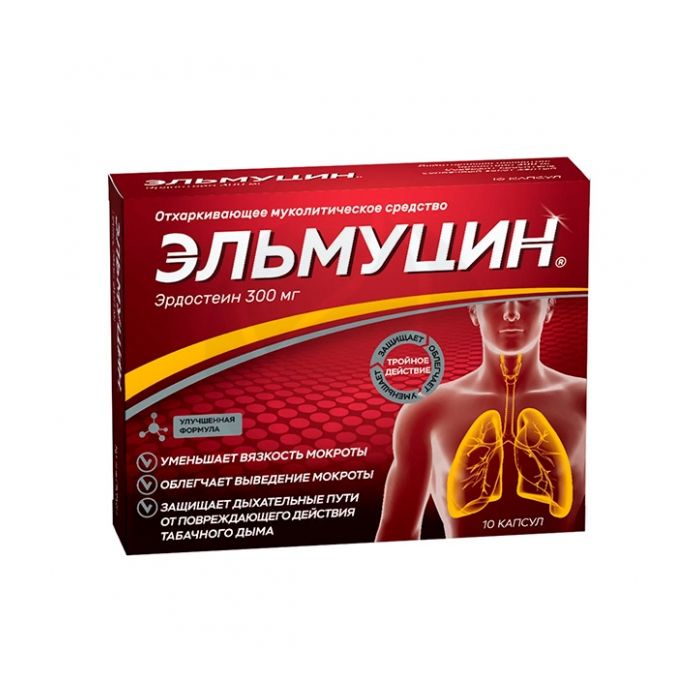Elmucin capsules 300mg, No. 10
Expiration Date: 05/2027
Russian Pharmacy name:
Эльмуцин капсулы 300мг, №10
Respiratory tract diseases with the formation of viscous sputum:
acute and chronic bronchitis;
pneumonia;
COPD;
bronchial asthma with difficulty in sputum discharge;
bronchiectasis;
prevention of pneumonia and pulmonary atelectasis after surgery.
It is taken internally. The recommended dose is 300 mg 2-3 times / day. If there is no improvement within 5 days after starting to use the drug or if the condition worsens, the patient should contact the attending physician.
Hard gelatin capsules No. 1, with a yellow body and a green lid; the contents of the capsules are white or almost white powder.
1 caps.
erdosteine ??300 mg
Excipients: microcrystalline cellulose - 13 mg, povidone (K-30) - 8 mg, magnesium stearate - 3 mg.
Liver dysfunction;
renal failure (CC <25 ml / min);
homocysteinuria (the drug is a source of homocysteine, therefore, metabolic disorders of amino acids are possible in patients on a diet with a reduced content of free methionine);
I trimester of pregnancy;
lactation period (breastfeeding);
children and adolescents up to 18 years old;
hypersensitivity to erdosteine.
pharmachologic effect
Mucolytic agent. The effectiveness of erdosteine ??is due to the action of active metabolites. Thiol groups of metabolites cause rupture of disulfide bridges, which bind glycoprotein fibers to one another, which leads to a decrease in the elasticity and viscosity of sputum. As a result, erdosteine ??enhances and accelerates the release of the respiratory tract from secretions, improves the secretory function of the epithelium and increases the efficiency of mucociliary transport in the upper and lower respiratory tract. Erdosteine ??has an antioxidant effect and carries free radicals; in particular, erdosteine ??protects the airways from the damaging effects of cigarette smoke to inactivate alpha-1 antitrypsin.Erdosteine ??increases the concentration of IgA in the mucous membrane of the respiratory tract in patients with chronic obstructive respiratory diseases, and also reduces the suppressive effect of tobacco smoke on the function of granulocytes. The therapeutic effect of drug therapy develops on 3-4 days of treatment. Erdosteine ??as such does not contain free SH-radicals, and therefore does not have a damaging effect on the gastrointestinal tract.
Pharmacokinetics
It is rapidly absorbed from the gastrointestinal tract. Repeated use or concurrent food intake does not affect pharmacokinetic parameters. Cmax - 3.46 ?g / ml; Tmax - 1.48 h; AUC 0-24 h - 12.09. Plasma protein binding is 64.5%. Up to three active metabolites are metabolized in the liver, the most important of which is N-thiodiglycolyl-homocysteine ??(Metabolite 1 or M1). T1 / 2 - more than 5 hours. It is excreted in the form of inorganic sulfates by the kidneys and through the intestines. In case of liver dysfunction, an increase in Cmax and AUC values ??is noted. An increase in T1 / 2 is possible with severe liver dysfunction. With renal failure, the accumulation of metabolites is possible.
Side effect
From the digestive system: rarely - heartburn, nausea, diarrhea; very rarely - at the beginning of treatment, a loss or change in taste sensitivity is possible. Allergic reactions: rarely - skin redness, urticaria.
Application during pregnancy and lactation
Use in the first trimester of pregnancy and during lactation (breastfeeding) is contraindicated. Application in the II and III trimesters of pregnancy is possible only if the intended benefit to the mother outweighs the potential risk to the fetus or infant.
Application for violations of liver function
The use of the drug is contraindicated in case of impaired liver function.
Application for impaired renal function
With renal failure, the accumulation of metabolites is possible. The use of the drug is contraindicated in renal failure (CC <25 ml / min).
Application in children
The use of the drug in children and adolescents under 18 years of age is contraindicated.
special instructions
With the irrational use of antitussive therapy, it is possible for the accumulation of liquid secretions in the bronchi and an increase in the risk of developing superinfection or bronchospasm. With renal failure, the accumulation of metabolites is possible. With severe liver dysfunction, an increase in T1 / 2 is possible.
Drug interactions
When used together, erdosteine ??increases the concentration of amoxicillin in bronchial secretions, which makes it possible to achieve a faster response to therapy compared to monotherapy with amoxicillin.

